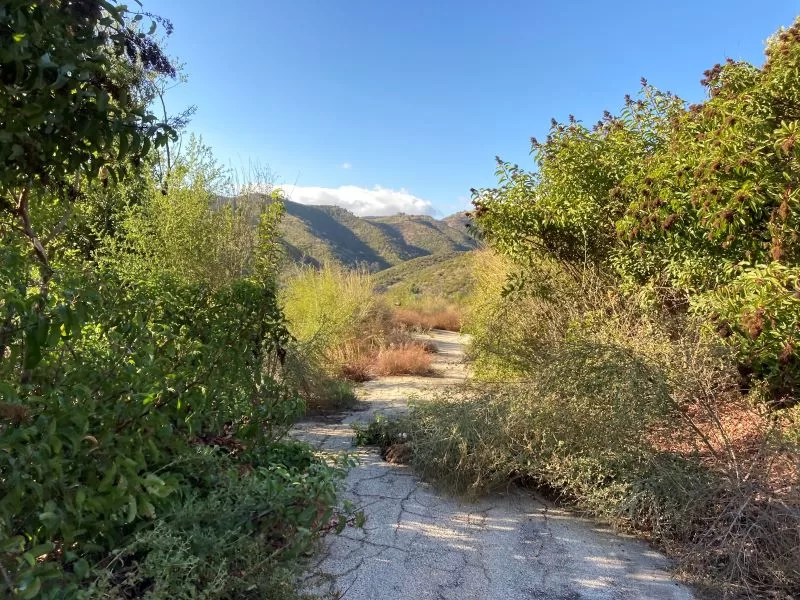
If we have not found the heaven within, we have not found the heaven without…”
When I was a child, there was a magical place deep in a canyon in the Santa Monica Mountains where Christmas trees grew—a sort of seasonal Shangri La. The Malibu Christmas Tree Plantation operated every December, from 1968 to 1978.
For a small child, it was indescribably exciting to walk into that seven-acre forest of Christmas trees, smell the exhilarating tang of pine and look for just the right tree, i.e., the biggest one we thought we could talk our parents into buying. The price in 1976 was $1.50-$3 a foot, or $16-$25 for a potted tree.
The owner of the plantation was Turlow Orrin McCoye. The Christmas trees were, presumably, more of a hobby than a serious business venture. McCoye, born in 1893, had already enjoyed a long and successful career in real estate when he moved to Malibu in 1959. He is credited with selling the first lot in Playa del Rey and he opened that community’s first grocery store. His daughter Barbara was the first child born in the newly created town in 1915. McCoye sold real estate in Playa del Rey and Venice for 50 years before retiring to Latigo Canyon, where he purchased a hundred acres.
His original intention appears to have been to subdivide the land and sell it. A 1966 real estate ad in the Los Angeles Times describes the property as “Vista Malibu, a progressive community in the heart of Malibu…with view lots from $2,950.” By 1970, McCoye was advertising the property as: “park-like setting and spiritual retreat…revenue from 2,000 Christmas trees which makes this property nearly self-supporting.”
While he was waiting to find the ideal buyer, McCoye transformed his Malibu retreat into his own terrestrial paradise, planting a fantastic orchard of tropical fruit trees, gardens filled with succulents, roses, and herbs, a grove of redwoods, a fern grotto kept moist by man made waterfalls fed by springs, and Christmas trees: seven acres of Aleppo and Monterey pines, growing on the steep sides of the canyon.
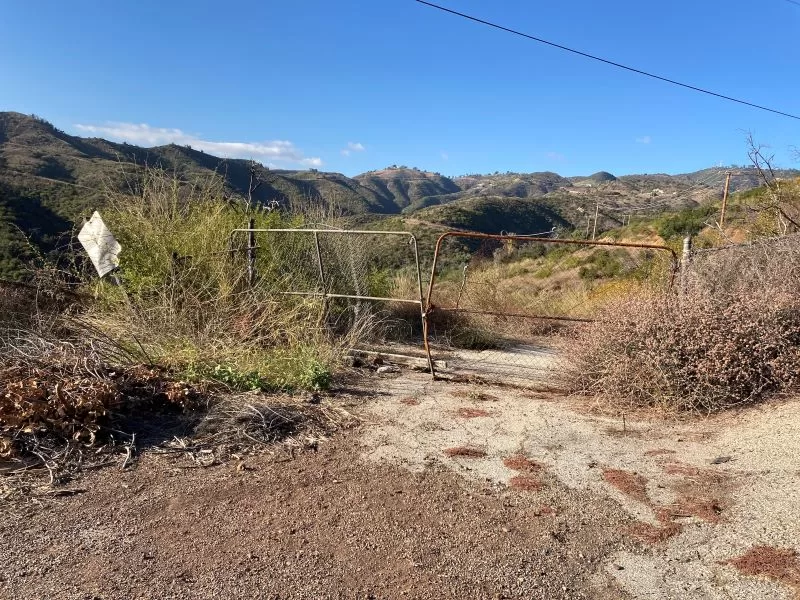
McCoye was an early proponent of organic gardening, and he became a local countercultural figure, a friend to the Nature Boys, and a father figure to a sort of informal hippy commune that provided cheerful if haphazard assistance growing the trees and handling the strenuous job of chopping the trees down or digging them up, and stuffing them in or on top of cars for customers to take home.
These were genuine flower children, with long hair, cut-off jeans, and bare feet, despite the winter weather. They lived on the farm in tents and cabins and reportedly even in a couple of caves by the creek, working on the property for a few days, weeks, or months in exchange for room and board, before moving on to San Francisco or Mexico or wherever the open road called them.
The highlight of visiting the plantation for me as a child was a trip to the three-story tree-house perched on a hillside among the pine trees. It was shaped like a stylized Christmas tree and decorated with round, colored plexiglass windows that resembled Christmas tree balls. Inside of this green-painted plywood folly were two precipitous stairs.
I was only allowed to go up to the second level, but my big brothers were permitted to climb the ladder to the forbidden third level, hidden behind a trap door. From there, you could look out through the red plastic window and see a strange pink landscape spread out below.
Old Mr McCoye always said, “next year you will be big enough to go up there, too.” I was convinced that climbing to that third level was somehow an extraordinary experience on the level of climbing through the wardrobe into Narnia, but I never had the chance to find out. I was, alas, never old enough or big enough.
The farm closed in 1978, and later burned. After McCoye’s death in 1981, the property was at the center of a legal battle between his daughters and his caregivers. Eventually it was sold, and sold again. Various plans for the property materialized over the years, including a conference center and self-catered vacation yurts, but the would-be developers ran into the same problems faced by McCoye: steep, unstable hillsides, and an environmentally sensitive stream, one of the rare ones in the local mountains that run year-round.
In 2013, the Mountains Recreation and Conservation Authority purchased 86 acres of the original hundred-acre property. At the time, Paul Edelman, the MRCA’s deputy director, described the park as “a bit of a Shangri-La.” And in a way, that’s exactly what this place is, a retreat from the noise and haste of the world.
I interviewed McCoye’s grandson, Arthur Bradley Fowler, in 2016. He had written a book about McCoye based on a wealth of photos and documents he discovered after his grandfather’s death. He described the Latigo property as a children’s paradise, where he and his cousins spent summers and weekends swimming in the pools his grandfather created along Escondido Creek, discovering the canyon’s secret treasures—wildlife, massive oaks, and seasonal waterfalls—and helping to harvest crops like nectarines and peaches from trees weighed down with fruit.
“My grandfather was into health food before there was health food,” Fowler said. “Everything was organic. He grew every kind of fruit and vegetable.”
He added that counterculture icon and health food advocate Gypsy Boots, the inspiration for Nat King Cole’s song “Nature Boy,” was a good friend of his grandfather’s and a regular visitor. Ranch visitors were always presented with fresh herbs and other garden bounty, including homegrown macadamia nuts.
“My grandfather was a great guy,” Fowler said.
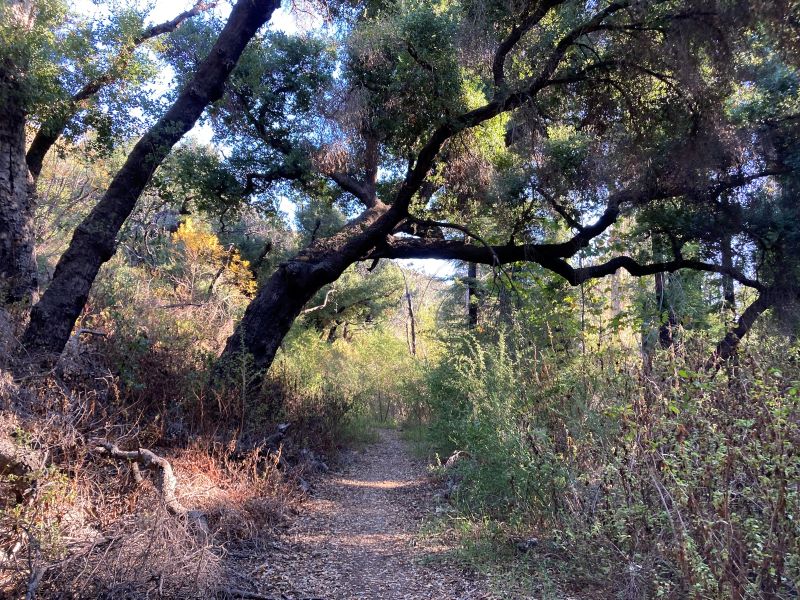
Fowler told me that his grandfather always hoped the property could be open to the public as a botanic garden. More than 50 years after McCoye first moved to the canyon, that wish became a reality, not exactly as a botanical garden, but as an open space park that still contained many of his prized botanical specimens. However, in 2018, just three years after the property became a park, the land burned in the Woolsey Fire and the damage was extensive.
I went back this December for the first time since Woolsey. I expected the worst. I had been told that nothing was left of the Christmas plantation, but trees are resilient and they live for a long time. So I went.
The gate had a “No Trespassing” sign on it, but an email exchange with the MRCA confirmed that the message was a contribution from a neighbor who would prefer to keep the public out. Even with that knowledge, I had the uncomfortable feeling of someone who shouldn’t be there, but within a few yards the feeling of tranquility and the murmur of running water worked their magic. This wasn’t paradise lost. There were fallen trees in the path, and ivy overgrowing the stones that are the last remnants of Thurlow McCoye’s garden, but it was still Shangri-La, and there were signs that a work crew had been here recently, cutting deadfall trees, clearing a path.
It’s astonishing how quickly nature reclaims places humans have abandoned, and heartening to see how fast the native plants and animals recover after a fire, even a catastrophic one like Woolsey.
Birds rustled among the brush. A spotted towhee, digging through the leaf-litter, sounded like an animal a hundred times its size. Once, I startled a covey of quail out of the brush. The thunder of their wings gave me a fright in turn. I encountered only birds, no other animals or people.
Here was the old herb garden, so overgrown that I almost walked by without seeing it. A bit of scrabbling revealed the two messages written on the stone step to the forgotten garden: “Enter and become fugitives from the bondage of routine,” and, “His strength is the rock on which all fears are shattered into nothing.” The first was poet Henry Van Dyke, the second is signed TOM—Thurlow Orrin McCoye.
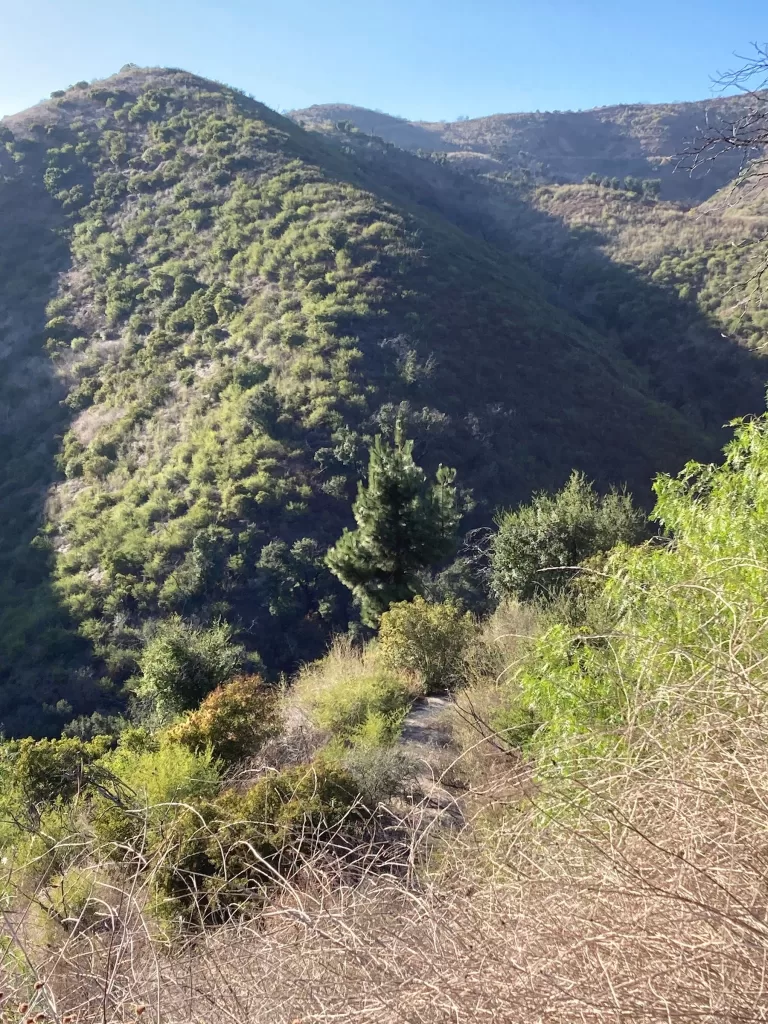
A little further down the trail the redwood grove still grew by the creek. The trees had been burned in the fire but five years after Woolsey they appeared to be thriving again. Ten thousand years ago redwoods were natives of the Santa Monica Monica Mountains. This small grove is one of two I know of in the local mountains that were planted in the mid twentieth century and continue to survive.
There were other more exotic trees here, too—remnants of the old orchard, but there was no sign of the Monterrey and Aleppo pines that once covered the steep sides of the canyon—the two thousand Christmas trees that could, according to their owner, provide a comfortable living. This is a small park. The trail—once the paved road through the property—soon leaves the creek and winds back up the hillside towards Latigo Canyon Road. There were the skeletons of pine trees on the hills as I climbed, and weather-bleached pine cones on the ground. They were already disappearing beneath a new green tide of native shrubs and trees, including coast live oaks. I was almost to the road and had paused to catch my breath and look back into the canyon when I saw it: one lone Monterey pine, towering above the scrub, green and growing. I know pine trees have no place in the current ecology of the Santa Monica Mountains, but my heart leapt to see it: the ghost of Christmases past, alive and well. A new Christmas memory to take with me into the future.
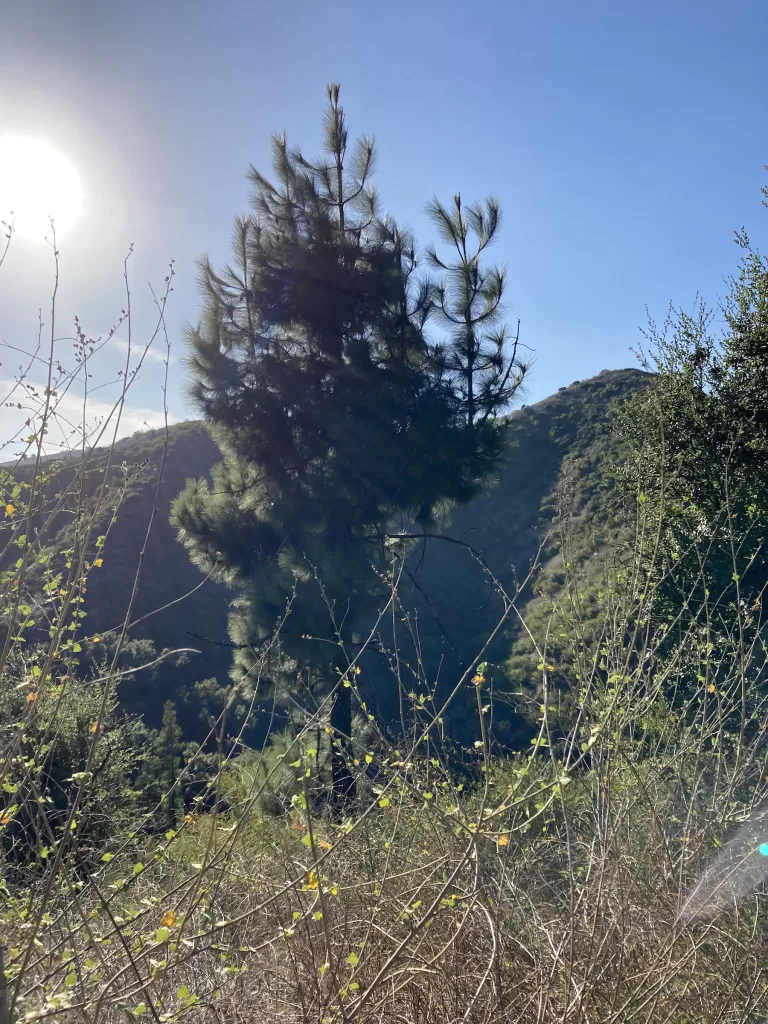
The Malibu Christmas Tree Plantation is now Ava and Cole Weintraub Family Park—named for the family who sold the land to the Santa Monica Mountains Conservancy. It’s a Mountains Recreation and Conservation Authority open space park. It’s still in rough shape from Woolsey, but it is open to the public—no matter what the sign says. It’s a short trail. The segment by the creek is suitable for families and children—just watch for poison oak. The climb up the hill is still rough and involves stepping over a couple of fallen trees. Hikers who would prefer a bigger challenge can check this park out and then head up to the Backbone Trail, which crosses Latigo just a few miles further up the road. The main entrance to Weintraub Park is in a residential neighborhood with extremely narrow roads and a lot of post-Woolsey fire construction. Drive slowly and watch for trucks, pedestrians, children, dogs and wildlife. Learn more at mrca.ca.gov












